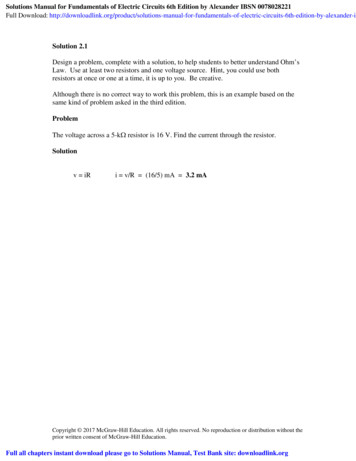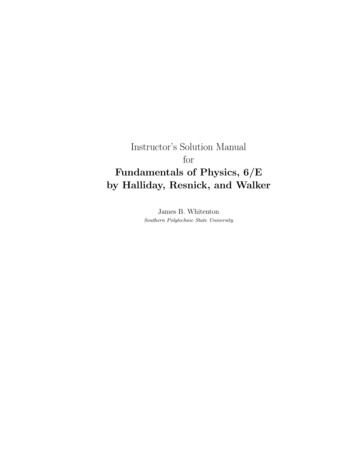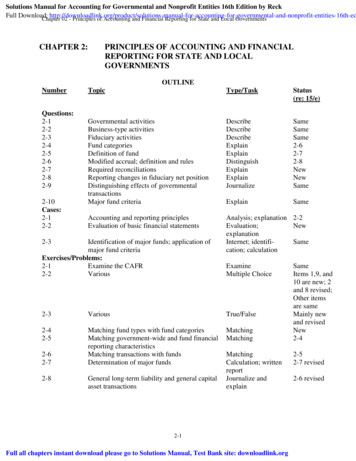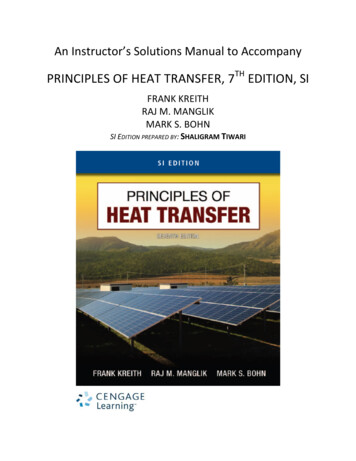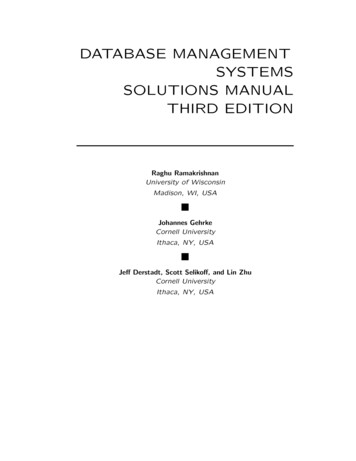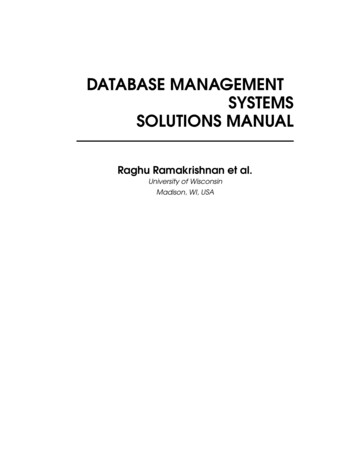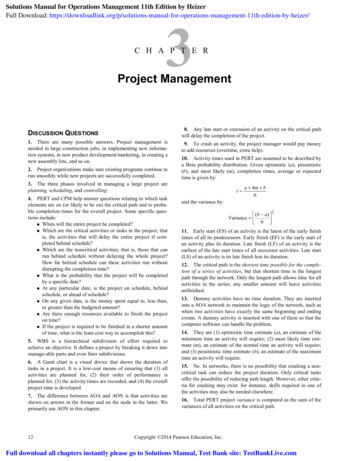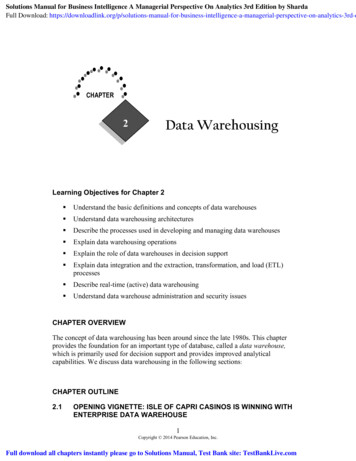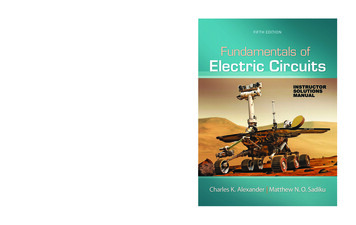
Transcription
Solutions Manual for Fundamentals Of Electric Circuits 5th Edition by AlexanderFull Download: xander/With its objective to present circuit analysis in a manner that is clearer, more interesting, and easier tounderstand than other texts, Fundamentals of Electric Circuits by Charles Alexander and Matthew Sadikuhas become the student choice for introductory electric circuits courses.FiFthEditionFiFt h EditionBuilding on the success of the previous editions, the fifth edition features the latest updates and advances in thefield, while continuing to present material with an unmatched pedagogy and communication style.Fundamentals ofPedagogical Features Matched Example Problems and Extended Examples. Each illustrative example is immediately followed by apractice problem and answer to test understanding of the preceding example. one extended example perchapter shows an example problem worked using a detailed outline of the six-step method so students cansee how to practice this technique. Students follow the example step-by-step to solve the practice problemwithout having to flip pages or search the end of the book for answers. Comprehensive Coverage of Material. not only is Fundamentals the most comprehensive text in terms ofmaterial, but it is also self-contained in regards to mathematics and theory, which means that when studentshave questions regarding the mathematics or theory they are using to solve problems, they can find answers totheir questions in the text itself. they will not need to seek out other references.Computer tools. PSpice for Windows is used throughout the text with discussions and examples at the end ofeach appropriate chapter. MAtLAB is also used in the book as a computational tool. new to the fifth edition is the addition of 120 national instruments Multisim circuit files. Solutions for almostall of the problems solved using PSpice are also available to the instructor in Multisim. We continue to make available KCidE for Circuits (a Knowledge Capturing integrated design Environment forCircuits). An icon is used to identify homework problems that either should be solved or are more easily solved usingPSpice, Multisim, and/or KCidE. Likewise, we use another icon to identify problems that should be solved or aremore easily solved using MAtLAB.Teaching ResourcesMcGraw-hill Connect Engineering is a web-based assignment and assessment platform that gives students themeans to better connect with their coursework, with their instructors, and with the important concepts that theywill need to know for success now and in the future. Contact your McGraw-hill sales representative or visit www.connect.mcgraw-hill.com for more details.Electric CircuitsINSTRUCTORSOLUTIONSMANUALMD DALIM 1167970 10/30/11 CYAN MAG YELO BLACK Fundamentals ofProblem-Solving Methodology. A six-step method for solving circuits problems is introduced in Chapter 1 andused consistently throughout the book to help students develop a systems approach to problem solving thatleads to better understanding and fewer mistakes in mathematics and theory.Electric Circuits the text also features a website of student and instructor resources. Check it out at www.mhhe.com/alexander.AlexanderSadikuCharles K. Alexander Matthew n. o. SadikuFull download all chapters instantly please go to Solutions Manual, Test Bank site: TestBankLive.com
Chapter 1, Solution 1(a) q 6.482x1017 x [-1.602x10-19 C] –103.84 mC(b) q 1. 24x1018 x [-1.602x10-19 C] –198.65 mC(c) q 2.46x1019 x [-1.602x10-19 C] –3.941 C(d) q 1.628x1020 x [-1.602x10-19 C] –26.08 C
Chapter 1, Solution 2(a)(b)(c)(d)(e)i dq/dt 3 mAi dq/dt (16t 4) Ai dq/dt (-3e-t 10e-2t) nAi dq/dt 1200 cos 120 t pAi dq/dt e 4t (80 cos 50 t 1000 sin 50 t ) A
Chapter 1, Solution 3(a) q(t) i(t)dt q(0) (3t 1) C(b) q(t) (2t s) dt q(v) (t 2 5t) mC(c) q(t) 20 cos 10t / 6 q(0) (2sin(10t / 6) 1) C10e -30tq(t) 10e sin 40t q(0) ( 30 sin 40t - 40 cos t)(d)900 1600 e - 30t (0.16cos40 t 0.12 sin 40t) C-30t
Chapter 1, Solution 4q it 7.4 x 20 148 C
Chapter 1, Solution 5101t 2 10q idt tdt 25 C24 00
Chapter 1, Solution 6(a) At t 1ms, i dq 30 15 Adt2(b) At t 6ms, i dq 0Adt(c) At t 10ms, i dq 30 –7.5 Adt4
Chapter 1, Solution 7 25A,dq i - 25A,dt 25A,0 t 22 t 66 t 8which is sketched below:
Chapter 1, Solution 8q idt 10 1 10 1 15 μC2
Chapter 1, Solution 91(a) q idt 10 dt 10 C035 1 q idt 10 1 10 5 10(b)2 15 7.5 5 22.5C5(c) q idt 10 10 10 30 C0
Chapter 1, Solution 10q it 10x103x15x10-6 150 mC
Chapter 1, Solution 11q it 90 x10-3 x 12 x 60 x 60 3.888 kCE pt ivt qv 3888 x1.5 5.832 kJ
Chapter 1, Solution 12For 0 t 6s, assuming q(0) 0,tt 00q (t ) idt q (0 ) 3tdt 0 1.5t 2At t 6, q(6) 1.5(6)2 54For 6 t 10s,tt 66q (t ) idt q (6 ) 18 dt 54 18 t 54At t 10, q(10) 180 – 54 126For 10 t 15s,tt 1010q (t ) idt q (10 ) ( 12)dt 126 12t 246At t 15, q(15) -12x15 246 66For 15 t 20s,t q (t ) 0 dt q (15) 6615Thus, 1.5t 2 C, 0 t 6s 18 t 54 C, 6 t 10sq (t ) 12t 246 C, 10 t 15s 66 C, 15 t 20s The plot of the charge is shown below.
140120100q(t)8060402000510t1520
Chapter 1, Solution 13(a) i [dq/dt] 20πcos(4πt) mAp vi 60πcos2(4πt) mWAt t 0.3s,p vi 60πcos2(4π0.3) mW 123.37 mW(b) W W 30π[0.6 (1/(8π))[sin(8π0.6)–sin(0)]] 58.76 mJ
Chapter 1, Solution 141 (a) q idt 0.02 1 - e -0.5t dt 0.02 t 2e -0.5t0(b) 10 0.02 1 2e -0.5 2 4.261 mCp(t) v(t)i(t)p(1) 10cos(2)x0.02(1–e–0.5) (–4.161)(0.007869) –32.74 mW
Chapter 1, Solution 15 0.006 2tq idt 0.006e dt e0(a)22 2- 2t 0 0.003 e 1 2.945 mC(b)-410di 0.012e - 2t (10) 0.12e - 2t V this leads to p(t) v(t)i(t) dt(-0.12e-2t)(0.006e-2t) –720e–4t µWv 3(c) w pdt -0.72 e0 720 -4t 6dt e 10 –180 µJ 403- 4t
Chapter 1, Solution 16(a) 30t mA, 0 t 2i (t ) 120-30t mA, 2 t 4 5 V, 0 t 2v(t ) -5 V, 2 t 4 150t mW, 0 t 2p(t ) -600 150t mW, 2 t 4which is sketched below.p(mW)30012-300(b) From the graph of p,4W pdt 0 J04t (s)
Chapter 1, Solution 17 p 0 -205 60 45 30 p 3 0p 3 205 – 135 70 WThus element 3 receives 70 W.
Solutions Manual for Fundamentals Of Electric Circuits 5th Edition by AlexanderFull Download: xander/Chapter 1, Solution 18p 1 30(-10) -300 Wp 2 10(10) 100 Wp 3 20(14) 280 Wp 4 8(-4) -32 Wp 5 12(-4) -48 WFull download all chapters instantly please go to Solutions Manual, Test Bank site: TestBankLive.com
Fundamentals of Electric Circuits iFth dition Alexander Sadiku With its objective to present circuit analysis in a manner that is clearer, more interesting, and easier to understand than other texts, Fundamentals of Electric Circuits by Charles Alexander and Matthew Sadiku has become the student choice for introductory electric circuits courses.
